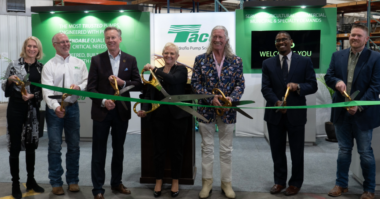Convincing a major player in the pulp and paper industry to break ranks and install a different kind of MC stock pump wasn’t easy, but after nearly a decade of trying, seepex, Inc. accomplished what they believe has the potential to become a new industry standard.
“Like most industries, over time, processes are refined. It’s a big ship to turn because in actuality you’re looking at a paradigm shift,” said Bob Baron, president and owner of R.W. Baron Process Equipment, the exclusive supplier of seepex pumps in Wisconsin and Michigan’s upper peninsula .
seepex, Inc., in Enon, Ohio, develops and manufactures progressive cavity pumps that are used globally in the chemical, paper, food, environmental engineering and petroleum industries.
In 2000, seepex shipped a progressive cavity pump to one of the largest producers of secondary fiber paper products serving industrial and institutional markets with a multiple machine mill in Green Bay, Wisconsin. The company had expressed interest in a seepex application, so seepex representatives showed up, pump at the ready, for a demonstration. seepex President Mike Dillon, Regional Manager Aaron Renick and Baron ran an open hopper pump that wasn’t connected to any production line for about 15 company employees.
The demo was, in Dillon’s estimation, a much sought-after opportunity because seepex had been looking for its first large stock pump application in the U.S. “We had some overseas and Canadian research in progress and our results were strong. Other companies had not been successful with progressive cavity pumps for this application in the pulp and paper industry,” Baron said.
During the demonstration, the research and development team at the mill kept increasing the consistency of the paper stock. “When we ran the trial, they kept adding more fiber to see how high they could go and the pump just kept pumping it. The rate moved into the 12% range and they were surprised to see the pump continue to work,” Baron said. Consistency – the ratio of fiber to water – varies depending on the paper being made and fiber used and can range as high as 20% at the top end.
The trial was successful, everyone in Wisconsin seemed pleased and the seepex team went home with a feeling that there was potential. Then nothing happened for almost nine years.
In 2008, seepex heard from the paper manufacturer again and jumped at the chance to provide a solution to what could have been a dire production problem. The facility’s existing twin screw pump, a typical choice in the industry, was being used to pump fiber at the plant and needed to be replaced with the next larger size to accommodate the rate of flow and reduce wear and maintenance. However, the existing physical space would not accommodate the larger pump.
The height of the new twin screw pump would be too tall to fit under the refiner and would have required modification of the building. That’s when the paper manufacturer thought of seepex. “The twin screw pump was installed underneath a refiner to pump fiber to another machine and the company asked if we had a pump that could do that. We sent designs and drawings and they saw that our pump would fit into their existing space, saving a tremendous amount of money,” Baron said.
So, the company made the decision to change the pump instead of the building.
seepex didn’t have the luxury of merely waltzing in and saving the day. Other companies were bidding for that piece of prime paper-pumping real estate. “We actually had to compete against two of our competitors and the company made the decision in our favor because seepex was the best overall fit for their installation. So, what we’re doing for the company is exactly what they needed – we’re moving 1,100 gallons per minute of stock at 7% consistency against a pressure of 30 psi,” Baron said.
The pump has been in place since May 2009 and runs non-stop unless the mill is down, which equates to about 50 weeks per year. The mill has two of the pumps at the facility so one is readily available at all times. The original pump has never broken down or stopped running, but has been taken out and replaced with the back-up for maintenance purposes only.
Removed earlier this year, the pump was shipped to seepex U.S. headquarters in Enon, Ohio for service. “It had not stopped pumping nor was it compromised, but on a routine inspection, it was discovered that a section of the auger had cracked and the cavity liner had worn through to the metal. At no point in the production process did the pump lose capacity. Folks at the mill are pleased. I spoke with an engineer involved with the project who told me it continues to do a good job for them,” Baron said.
The seepex Difference
From a broad-brush perspective, Baron said, the seepex design is original and the resulting pumps are built to be durable and easily serviceable. “The initial designs were created in the early 1970s but most competitors’ designs date back to the 1950s. And, some companies rely on modification of an existing design which results in something that isn’t necessarily ideal and may have a compromised end result. At seepex, the manufacturing tolerances are more tightly controlled and our materials are better-suited for these specific applications.”
There are many standard components to the progressive cavity pump (the shaft, rotor, stator and universal joint, for example), but seepex has engineered those components to surpass those of their competitors, regarding varieties of designs, materials, tolerances and manufacturing processes. “seepex’s universal joint is the most elegant design out there – it’s extremely durable and easy to service,” Baron said.
seepex sets itself apart:
•The geometry of the rotors and the rotor coatings used are unique to seepex.
•Rotors and stators, the working parts, have to be durable, so the seepex coating – which is proprietary – is incredibly durable and stands up to abrasion.
•Special attention is paid to the fit between the rotor and stator because that relationship is critical to the pump’s performance and longevity.
•Rotors are typically made from metal but the seepex designs easily allow for the appropriate use of exotic materials, like duplex stainless, titanium, Hastelloy and Alloy 20.
•seepex uses over 25 standard elastomers that are needed for specific applications.
•The ideal compression between the rotor and stator is maintained to ensure maximum performance with the tight quality and consistent processes used by seepex for stator manufacturing.
“The rotor is slightly larger so the stator is compressed to create the perfect sealing line for the internal cavities. Maintaining that sealing line is extremely important and is something seepex really pays attention to. And, we do that better than our competitors,” Baron said. “It’s a fine balance to create proper compression for a specific application.”
seepex has one unique component not available on competitors’ pumps — a device that reliably protects the pump from dry-run damage. That type of damage can occur when the stator is not properly lubricated, causing the rotor to burn the stator’s elastomer and potentially resulting in catastrophic pump failure. If there is a problem upstream and the flow stops, the pump is safeguarded by the seepex “TSE” run-dry protection device. A thermal sensing element monitors the rotor temperature during every revolution of the rotor, and temperature thresholds are established so that if the rotor’s temperature goes above that range, the pump is shut down. The system can be set up to sound an alarm and/or automatically shut the pump off. This device, exclusive to seepex for over 20 years, is highly effective because it senses the root cause of run-dry failure and eliminates the chance of a false reading.
Meeting individual needs, moving into new markets
Unlike its competitors, seepex creates original pumps for most of its customers. “Our approach to the marketplace is to design pumps for every application. We do offer some standard pumps, but for us that’s rare. When you get into the actual processes for various industries, be it food, paper or waste water treatment, you need a specifically-designed pump for that application and location,” Baron said.
For seepex, the pump installed at the paper mill is an unusual application at this point in the company’s history, but the tissue and paper towel industry is a growth market for the pump experts. “In this specific application, the twin screw pump is the standard, so deviation from that requires a special set of circumstances, like the physical size limitations dictated by the facility in Wisconsin,” Baron said. Now that seepex has a successful application in a major production facility, the pump producer believes others in the pulp and paper industry will start to notice and more change will come.
“Bottom line,” Baron said, “the seepex pump solved serious issues for a major paper mill and the potential to offer the same solution with other mills certainly exists. Similar pumps could be used in the ethanol industry and in municipal or industrial waste processing because, as we’ve seen at the facility in Wisconsin, the pump has a strong ability to move high-solids materials that are thick or viscous and fibrous.”




Comments